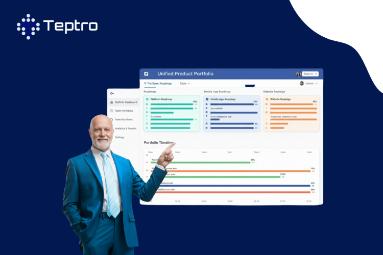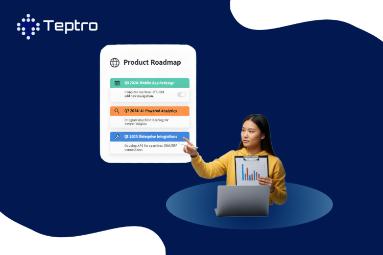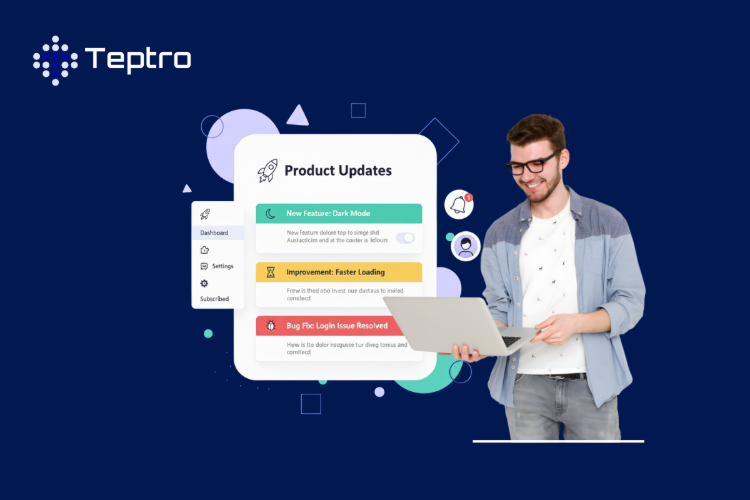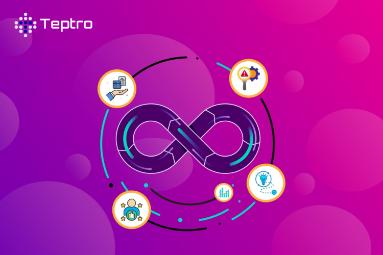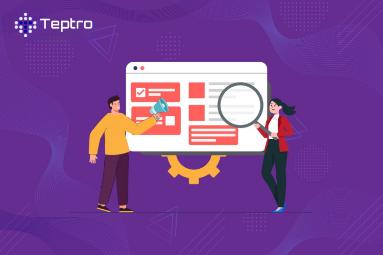Top 12 Strategies to Encourage Customers to feedback management
In today’s constantly changing business landscape, storing positive or negative consumer feedback management systems can serve as a customized guideline to elevate your offerings, improve brand reputation, and , ultimately , increase business revenue. Here’s the catch that most businesses face: unsuccessful attempts to collect feedback or brand experiences from existing customers. Well, this isn’t the end of your business growth. Teptro understands your concerns, and that’s why simplifies the process by offering a centralized feedback management system. However, most companies struggle with inviting or encouraging customers to share their experiences with the brand feedback management systems. Don’t worry; understanding consumer’s perspectives can help you strategize better ways to encourage consumers . How? By assessing why they dislike your product, what they need, and what the challenges they faced while using your offerings are . In this blog, we will help you understand critical considerations to help target consumers’ needs, strategies to pull more data through a customer feedback management system, or more methods to help you improve brand engagement and feedback management pricing plans to help you make decisions accurately for brand enhancement. Why does Customer Feedback Matter? Customer feedback management is a valuable asset for business growth. It offers insights into factors like customer preferences and average satisfaction level , aids in identifying loopholes in your product, and more through feedback management systems. In short, if planned correctly, customer feedback is your data to strategise a product roadmap and improve further innovations. Encouraging customers to share their feedback may feel challenging. Still, with the right engagement strategy, you can encourage your customers to post feedback, like, vote, and interact with other users by leveraging centralized feedback management systems. How to inspire customers to share brand experiences? One of the ideal tools for businesses to grow and improve offerings includes collecting feedback. And when you integrate brand engagement strategies with customer feedback management software, it offers valuable insights into areas of improvement, customer satisfaction, and more factors. To help varied businesses elevate their brand offerings, we will discuss top strategies to encourage customers to seamlessly share their experiences with your brand . 1. Understand Customer’s Needs Before you strategize your marketing or engagement strategies with feedback management systems, understand what your customers need. Consider conducting surveys, research, and interviews, or invite customers from varied channels to a centralized feedback management system. In addition , utilize communication data to identify customer behavior , preferences, and pain points and integrate this data with your strategy for new releases. 2. Provide Simple Feedback Methods Many individuals are happy to share their experiences and become your brand representative. However, when they realize the method for sharing feedback is time-consuming and tedious, they would abandon the process immediately. So, to avoid such circumstances, organizations must make sure: To optimize the feedback process by providing varied feedback channels Gather feedback with user-friendly customer feedback software Provide instructions about the feedback-collecting process Optimize your web interface for effortless feedback submissions In addition, to save your customers time, consider implementing one-click feedback options, which enable consumers to share within seconds and automate the process for organizations to seamlessly analyze user feedback . 3. Ask for Feedback, and not Testimonials We know you must be wondering – isn’t that the same thing? Well, when people are asked for testimonials, they may appear unnatural and promotional to other perspectives. Plus , it consumes a lot of hard work and time for your customers to consider and specify certain factors. Whereas, if you ask your customers to share genuine feedback, they will be honest with their opinions, and in some cases, you will receive a few valuable suggestions that can be worked on . In addition, you can personalize a few questions and ask your consumers specific questions to understand where you lack and what consumers expect from you and analyze user feedback in simple steps. 4. Offer Value and Price For Their Feedback Another impactful way to motivate your customers to share feedback includes offering value and prices that meet what they are seeking. You can begin by providing incentives, rewards, accurate solutions, and discounts that focus on solving customer’s problems and boosting customer satisfaction. In addition, you can consider highlighting your USP, competitive advantage, and social proof of your brand. By offering such benefits, you show your customers how your brand helps the audience meet their needs. This will encourage people to notice your brand, and existing customers will feel valued, increasing the chances of spreading word of mouth over varied channels. 5. Foster Emotional Connection Every human being connects when there is emotional connectivity ; in the case of brand image, this works beautifully as customers stay with the brand for a longer time, which means brands can rely on these customers to gain perspectives, opinions, and suggestions seamlessly. But this won’t happen overnight. Brands need to maintain a standard message and brand image. You can consider storytelling, empathy, humor , or customization in your customer interaction strategy. In addition, utilize a positive tone and gesture to showcase warmth, enthusiasm, and gratitude to make your customers feel your brand is meant for them. By implementing emotional appeal, you will build trust and loyalty. 6. Timing is Everything Yes, you hear it right! Timing is crucial when you consider collecting feedback, even with customer feedback software. If you ask for feedback incorrectly, you may not get accurate data or good responses as expected . Consider collecting feedback when the customer’s experience with your product is still fresh. For instance, ask customers for feedback after purchasing or when interacting with your support team. This will make sure that customer feedback is relevant and genuine based on recent experience . 7. Optimize Surveys You can utilize surveys to get your customers’ feedback but remember to integrate surveys with other customer interaction methods. One ideal way is to attach organized , short surveys containing specific questions to your email newsletter. Furthermore, consider open-ended questions to allow customers to provide suggestions they think your brand can utilize to meet their expectations. These are the types of surveys you can leverage with: Behavioral insight Surveys Mobile Surveys Customer Surveys And More 8. Challenge your Customers This strategy can work by challenging your customers to perform specific actions, making them enthusiastic about completing the task. Consider utilizing fun interaction methods like quizzes and interactive feedback loops or creative polls to analyze user feedback effectively. In addition , utilize a call to action and social influence to inspire your customers to share their experiences. One of the ideal examples includes – Giveaway campaigns, where you can create a buzz with interactive activities and promising exciting rewards. This stimulates the audience’s curiosity, interest, and excitement to share brand experience. 9. Target Social Media Platforms Today, every organization can benefit from social media tools. If your company’s target audience includes youth, you are more likely to receive prompt responses through social media platforms. This doesn’t mean that you cannot encourage customers to share feedback on social media if your product caters to other age groups . Utilize engagement strategies, create a space for your customers to share their problems, and promptly respond to their complaints or positive experiences. Feedback on social media can take the form of lively chats wherein customers and suppliers seamlessly exchange opinions. Organizations need to track these conversations to stay relevant to the audience and identify what people have to say about them. In addition , complaints can be used to impress unsatisfied customers by solving their concerns. Furthermore, these conversations serve as a review for prospective consumers and, for some, a source for purchasing decisions, so make sure the ratio of recurring complaints is less to maintain the right brand image. 10. Ask Your Focused Community A focused community can help you gain accurate customer reaction data, especially when you have recently launched an innovative solution. You can consider Teptro's feedback management system ; it enables businesses to invite customers, encourages them to share feedback under one feedback , and offers features that allow other community members to like, interact, or vote on a few relevant feedbacks . This strategy combines varied customers from various locations to collect relevant responses in the most straightforward method through feedback management syste m. 11. Conduct Usability Test Most companies, especially in the IT industry, collect feedback by conducting usability tests before launching a product or service. This method enables customers to offer indirect feedback on the problems they face that the organizations may have missed out on . For example, using a website, you can observe how visitors navigate the website to complete specific tasks like clicking on demo calls, payment processes, and more. This process helps improve user experience and solve any potential bugs before launching the product. Companies from varied industries can consider this strategy, as it indirectly enables you to identify potential bottlenecks , and by sending automated notifications by utilizing a feedback management system, your focused community will be happy to undergo the test. 12. Customize your Feedback Process Small things matter: use the customer’s name in an email newsletter to give a personal touch. Personalize feedback forms based on your customer’s previous interactions to make them feel valued. Offer tailored incentives or rewards for providing feedback. Provide customized discounts or special deals based on previous customer data when they provide valuable feedback. Create personal follow-up actions based on their feedback Individuals are more likely to associate themselves with someone, a group, or a brand when they feel valued, trusted, and communicated on time . A personal message offering rewards on special occasions to your loyal customers will make them help you whenever you need their actions . Final Thoughts on Feedback Management Software Feedback is valuable for every organization seeking to grow and improve their offerings. Plus, insightful feedback data is the first step towards planning a robust product roadmap, so encouraging customers to provide feedback is essential. We hope the strategies discussed in the blog were helpful for you, integrating them with a robust feedback management system for improved success. Do you want to know more about Teptro and how Teptro’s feedback solution works? Or learn about feedback management pricing plans, then get in touch with us today !







